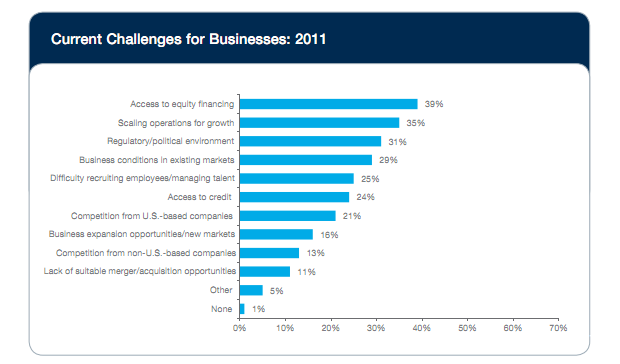When discussing the current crowdfunding taking place, the question is raised: “why are people doing this?†If only 43% of projects on Kickstarter succeed, why aren’t people crying foul but instead pledging more than ever before? ($9M in December, 2011 on Kickstarter compared to $4m in January, 2011). The answer is simple. They want to help someone they know. They want to support an idea. They want to be part of a community and they want some recognition for it. People are drawn to crowdfunding because they are capitalists. They admire entrepreneurs, and they know that sooner or later they may be entrepreneurs as well.
What are they basing it on? It comes down to trust and transparency. AirBnB is one of the nation’s fastest growing crowd sourcing startups focuses on renting other people’s floors, rooms, homes, yachts – even igloos. It is growing at a staggering 45% per year because people trust the system, vet the offerings and rate them as well. On the Internet, when your “wares are out there,†it is on the line for everyone to see. By being transparent, you build trust. Users check out the reviews, read what other people are writing and make careful and informed decisions. All of this is recorded and becomes part of a larger “self-Âpolicing community†of profiles for both parties and a greater community rating system. These reputations today are carrying across the web from eBay to Tripadvisor to Rate-Âaâ€VC.
Other companies like TrustCloud aim to become a portable reputation system where their algorithm collects your online “data exhaust†– the trail you leave as you engage with others on Facebook, LinkedIn, Twitter, commentary-Ââ€filled sites like TripAdvisor and beyond – and calculate your reliability, consistency and responsiveness. The result is a contextual badge you carry to any website, a trust rating similar to the credit rating you have in the offline world. These are tools that can and will be incorporated into any online crowdfunding platform to help foster transparency and accountability.
We think any of you would find it hard to disagree with this statement, “the internet today has made the world a more transparent place. Your actions are followed and the opinions flow freely.â€
According to the Sustainable Economies Law Center, “The success of crowdfunding sites demonstrates the desire of the public to support projects that they believe in. Enabling the additional motivation of possible financial return would only reinforce this economically healthy impulse.â€
But crowdfunding goes beyond money, experience or trust. Michael Shuman, author of The Small Mart Revolution: How Local Businesses Are Beating the Global Competition, states “Crowdfunding has the potential to deliver the jobs Americans have been longing for. We know that small businesses, especially locally owned ones, are key for expanding the nation’s employment, and these businesses comprise (by output and jobs) more than half the private economy. And yet almost none of the $30 trillion we have in our long-Âterm investments (stocks, bonds, pension funds, mutual funds, insurance funds) touches these businesses. This is a colossal market failure, driven by obsolete securities laws. Moving even a few percentage points of our capital into local, small business could effect a stimulus home run.â€
So let’s address all the naysayers. What if we carve out an exemption and it all comes tumbling down? What if we open the doors to defrauding thousands of people out of $80? Are these protectionists right? Will crowdfunding bring down the entire economy? To them we say, recall what happened in the Ireland Banking crisis of the late 70’s when the bankers went on strike and warned the public that the economy would collapse without a banking system. What happened instead was a peer-Âto-Âpeer banking system where the local pubs became de facto banks, lending money to their customers. It worked so well that some people even joked that there is no better judge of character than a bartender.
Opening the doors to a limited exemption will not cause the fraud that Worldcom and Enron did to their employees and investors, or that Wall Street and Bernie Madoff perpetrated on the American people. It will create a peer-to-Âpeer system where communities become the de facto seed and early stage funders to entrepreneurs. And if you think about it, there is no better judge of character in the United States than your neighbor, friends, and family.
But there are more reasons to trust the crowd. First, they are massively diverse. Fundamentally the collective IQ of the crowd works like this. Every time a new member joins who has one or more superior facets of IQ, the collective IQ is raised by those unique facets. Second, the values that VC’s claim to provide will be disrupted by the crowd. A VC’s Rolodex is easily replaced by social networks (i.e.: LinkedIn). And the Rolodex of a few thousand crowd investors is much stronger than that of a few VCs. Third, expertise – it is disputable that the people who manage money bring more operational experience to the table than an interconnected crowd of people, many of whom are investing in you because they understand your business. And finally, valuation sophistication – the crowd has been putting their value on things since the beginning of time. Price anything too high and no one will buy it.
These naysayers act as if crowdfund investing were made legal, then every American will dump their savings into this. So either that makes us think they REALLY think we have the solution to kick starting our economy and are afraid of money not being invested traditionally OR they think that everyone for some reason will see crowdfund investing as lower risk than any other choice they make in their daily lives when in fact we all know this isn’t true.
Crowdfund investing is more than just money – it is facilitation, diligence, team building, and valuation. Most importantly, it is jobs.
That being said, we shouldn’t assume that “everyone†will bring expertise. Some will be a marketing engine for the entrepreneur and others will just bring a few dollars. Collectively, they will gather behind entrepreneurs they believe in, they will fund only those they are willing to risk their investment in and they will invest only if they think what they are being offered is fair. Trying to circumvent the crowd to bilk them out of a lot of little dollars isn’t going to be worth the time or energy of a shyster.
There seems to be a general understanding in Washington that government spending stimulates the economy, but that when it comes to letting the average American decide how he or she wants to spend and/or invest his or her own money, then we need government oversight.
We stand at a moment in time when we can use crowdfund investing to start an education process. Where the average American who wants to be part of the process (mind you there’s no forcing here) can be taught to think like an investor and ask questions of entrepreneurs like, “How does your idea generate cash? Do you offer a product or service I would buy? What skills/experience do you have to be accountable with my money and why should I trust you?â€
In doing so, Entrepreneurs will learn how to communicate, be accountable and transparent, and investors will provide critical seed and early stage capital. Jobs will be created, innovation will be spurred and our economy will continue to grow.
We do not believe it is the role of government to limit how we can spend our money. Nonetheless, we appreciate their desire to protect our savings and so let’s have the discussion, “if you believe that $10,000 is too much for an American to risk, what is the smallest amount you believe I should be able to invest in my entrepreneurial friend without SEC scrutiny? If you are fine with $1, at what point are you uncomfortable?†That is the point whereby we should set the limit. I wouldn’t be surprised though, if we put it to a vote, the crowd would tell you “I’m an adult, I can make my own financial decisions.â€
If the dollar amount isn’t what concerns you but the potential for fraud, even at $1, then we need to have a frank discussion about that.
As Kevin Lawton, author of The Crowdfunding Revolution says, “Fraud isn’t really the issue, ‘Failure’ occurs much more frequently in startups.†According to a Kauffman Foundation survey, approximately half the time you will lose all or some of your investment. Just as you diversify in the publics markets to reduce exposure, having a portfolio of varied investments solves failure in the crowd funding space. As we have seen from over $500 million donated to projects and ideas through crowdfunding already, while people are concerned about losing their money, they are more interested in helping someone bridge the gap, bring an idea to fruition, succeed, and in the end being able to tell their friends and family they had a part in the creative and entrepreneurial essence of what it is to be American. It’s like paying for a brick in a new park or baseball stadium to be engraved with your name.
“Fraud is just some noisy component of failure,” As Lawton says, “and at that, it’s going to be pretty hard to get away with much of it when there are millions of eyeballs worth of visibility and mechanisms which social networking enables to further vet entrepreneurs.â€
And thus, the biggest problem we need to solve is education. Running a portfolio and understanding the risk-Âvs.-Âreward dynamics of investing in early phase companies is essentially an education problem. One way to solve the problem of unaccredited investors making investments, if you think of it as a “problem,†could be to make people ‘educationally accredited’. This can be done with a simple document, which explains the basics of the risk-Âvs.-Âreward curve of risk startups and the basic principles of a portfolio. It can be done in a few pages and can be sent out in paper form, transmitted via email as a pdf, or done online in a more scalable way via a platform. Before being allowed to invest, people would have to answer a series of questions that test their comprehension of the document.
Instead of pushing people down with a relentless assault on their intelligence, perhaps we should contemplate that people are adults and will make their own decisions. Our job should be to educate: education helps to create prosperity.
Education will teach the participants about analyzing and understanding risk. Nearly every company has a level of opacity. Even a brick-Âand-Âmortar restaurant business probably doesn’t give you their recipes. Tech startups don’t give you their ‘IP’, often not even to VCs. That’s how it is. Lack of complete transparency creates a level of risk, which is why we have varied portfolios. And within an open market, if an investor has access to two similar deals, one of which is more transparent, which do you think he’ll invest in? Concerns should be focused on the basics of investing, such as disclosures of the principal people in the company, details of the business model, use of funds and the securities offered.








